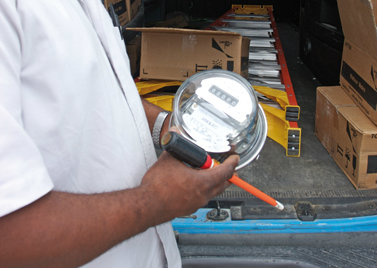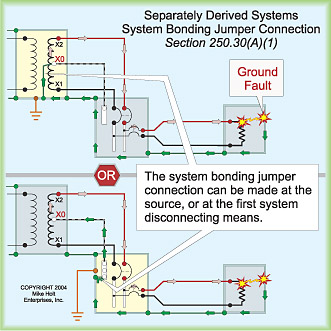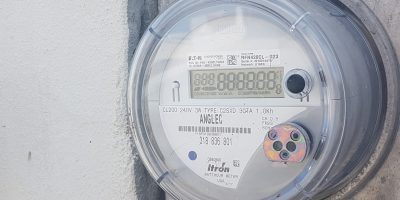Preventing Meter issues with Maintenance

Did you know that meter base maintenance in electrical services is the customer’s responsibility, in the same way that cell phones are the customer’s responsibility in telecommunication services? ANGLEC encourages you to ensure that your meter is in good condition at all times and that your electrical systems are bonded and grounded according to the correct standards.
The Importance of proper Neutral-Ground bonds and Meter Base Maintenance:
Many customer issues, such as damaged appliances, high bills, illegal connections and safety hazards arise when bonding and grounding are improper, when connections are damaged or when there is more than one earth to neutral bond.
Some customers with Powerline meter base connections may experience things like slack connections between the lugs and the terminal of the meter that must be corrected as soon as possible by a qualified electrician. We recommend that all customers consult a qualified electrician for meter base assessments and have their connections done according to the National Electrical Code (NEC) standard (please see below). Customers are allotted 1 free disconnection a year to allow for meter base maintenance by an electrician. For more information, please contact ANGLEC’s Customer Care unit via 497-5200.
Here are some tips for your electrician on proper grounding:
- the neutral-to-ground bond is needed to properly operate the circuit breakers. Over Current Protection Devices (OCPD) such as circuit breakers and fuses actually require a short and intense INCREASE in electrical current (a short) in order to detect the fault and cut the circuit off. Without a sharp and drastic increase in electrical flow, a fault could go on without triggering a circuit breaker to stop the flow. This actually occurs quite often and can be measured easily by checking the amount of current flowing on your ground conductor. It should be less than 1-amp in most cases. If the current flowing on a grounded conductor is higher than an amp, and you are not in a high-voltage (600V+) environment, it typically indicates a erroneous neutral-to-ground bond somewhere in the system.
- by getting an multiple (and illegal) neutral-to-ground bonds can exist in the system (only one bond is allowed in the main panel). When this occurs, both the ground and the neutral become current-carrying conductors, which effectively means that you have two (2) neutral wires running in parallel. This divides the current and places electrical energy on to the chassis of all metallic objects within the system. Another hazardous situation.
Chapter 7: Neutral-Ground bond-Where? Why?
The neutral and equipment grounding conductor are required by the National Electrical Code (NEC) to be bonded at the main service panel and the secondary side of a separately derived system (more on this below). Only one neutral to ground bond is permitted by the NEC to exist on each separately derived system. Improper, additional neutral – ground bonds are a relatively common problem that not only create shock hazards for operating personnel, but can also degrade the performance of electronic equipment. Improper neutral – ground bonds at receptacles can be detected using a wiring and grounding tester designed for that purpose.
A voltmeter can also be used to indicate if improper bonds exist at receptacles. A voltage measurement between neutral and ground at the outlets can indicate voltage ranging from a milli-volt to several volts under normal operating conditions and depending on loading, circuit length, etc. However a reading of 0 V can indicate the presence of a nearby neutral – ground bond. Excessive current on equipment grounds in distribution panels also indicates the possibility of a load-side neutral ground bond. Visual inspection of the neutral bus within panel boards is necessary to verify the location of these extra and improper bonds.
When more than one neutral – ground bond exists on a separately derived system – it results in the neutral and ground conductors being intentionally connected (or bonded) at two locations. This creates a parallel connection in which the neutral current is divided with a portion returning on the neutral and the rest returning to the source via the equipment grounding path according to ohms law (current will divided proportionally to take the path of least resistance with the voltage drop along each parallel path being the same). The figure below presents the two options to prevent objectionable current from flowing in the grounding (and bonding) system.

Separately derived systems are systems that have no direct connection between the output supply conductors and the input supply conductors. These are transformers with no direct connection between the primary system neutral and secondary neutral, only UPS systems that incorporate an isolation transformers thereby deriving a new neutral system conductor (note – all UPS Systems are not separately derived systems), and engine generators sets that connect to the building wiring system via a 4 pole transfer switch are separately derived systems because they have a separate neutral that has no direct connection to the utility neutral (due to the 4th pole of the transfer switch). Engine – generator sets applied with 3 pole transfer systems have a direct connection to the utility system neutral and are not separately derived systems and can not have a neutral ground bond at the engine generator set.
______________________________________________________________________________
For more information please call 497-5200 or visit us on Facebook.com/AnguillaElectricity.



